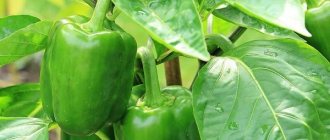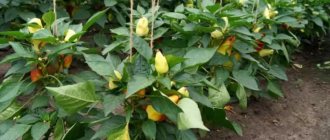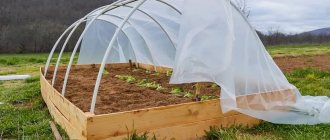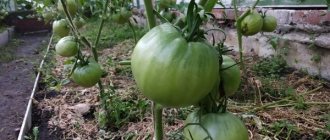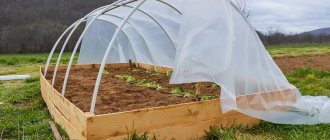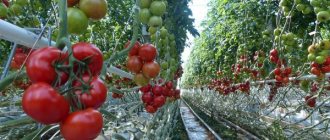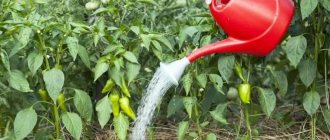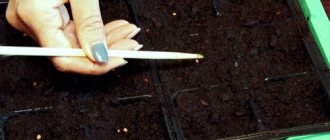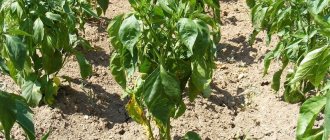Vegetable growing » Pepper
0
3293
Article rating
Kira Stoletova
The climatic conditions of our region do not always contribute to the full ripening of fruits. At the end of summer, when the nights are short and cool, this problem becomes very urgent. Experienced gardeners recommend speeding up the ripening of peppers on their own.
Acceleration of pepper ripening
Pepper maturity stages
The maturity of bell and bitter peppers can be of two types - biological and technical. In the first case, the pepper fruits fully correspond to the declared varietal characteristics - in color, size and taste.
Technical maturity is unripe fruits of greenish color. Pepper can be harvested at any stage of ripeness - biologically mature fruits are picked for fresh consumption and for preparing various dishes. At the stage of technical maturity, peppers are removed from the bush for canning and long-term storage.
Technical
Technical maturity is the stage of vegetative development at which the fruits already have the required size, but differ in color. If biologically ripe pepper can have a red, yellow, orange, purple or brownish color, then during technical maturity it is only green, slightly yellowish or whitish.
Technically mature fruits are removed from the bush for long-term storage (up to 8-10 weeks), transportation or sale.
Biological
Biologically mature fruits are fully ripe peppers with a characteristic red, orange, purple or black-brownish color with seeds. The fruits ripen gradually and can be picked from the bush every 5-7 days.
Such a harvest cannot be stored for longer than 10-13 days, so it is immediately consumed as food and used for preparing various dishes and winter preparations.
When growing hot pepper, you need to take into account that it is removed from the bush only after reaching full biological ripeness. Unripe fruits do not have a characteristic pungency; their taste differs from those stated in the description of the variety or hybrid.
Artificial ripening
Paprika has two stages of ripening - technical and biological.
You can use the fruits already on the first of them. A technically ripe fruit has all the properties of a biologically ripe fruit, except for color. It has a light green color.
To speed up the ripening of pepper fruits, use the artificial ripening method. To do this, remove technically ripe peppercorns. Store them in a dark, warm place. In three to four days you will have wonderful red bell peppers. Thanks to this method, the remaining fruits will ripen faster.
It is easy to speed up the ripening process of peppers. It is enough to redistribute the plant’s forces in the right directions. Use multiple methods to achieve results.
How long does it take for a pepper to ripen?
The growth and ripening of bell and bitter peppers takes place in several stages, each of which has its own characteristics.
- It takes 13-15 days from seed germination to the formation of strong and healthy seedlings.
- After the appearance of 2 cotyledon leaves, 17-20 days pass before the formation of the first true leaf.
- It takes the plant 6-7 days to form each further true leaf.
- The budding stage depends on the specific pepper variety and can occur 50-95 days after germination.
- After the formation of the first bud, 14-24 days pass until the stage of intensive flowering.
- It takes at least 5-6 days for each bud to bloom.
- From the date of formation of the ovaries to the stage of technical maturity, 25-30 days pass; after another 20-30 days, full biological ripeness of the pepper occurs.
The ripening time of bell and bitter peppers depends on their varietal. For early-ripening species, technical maturity occurs 75-80 days after the appearance of the first shoots, for late-ripening species - after 150-165 days.
Is it possible to ripen peppers at home?
Bell peppers can be ripened in much the same way as fruits. To ensure that the fruits reach biological maturity and do not deteriorate, turn red or lose their taste, they are placed in a warm and dark place for 4-5 days.
How to ripen peppers:
- First way. Place the peppers in a dark room, such as a pantry, and place one red pepper or ripe apple between them.
- Second way. Place food foil on the windowsill. Better on the north window. Place unripe peppers on foil. They will be exposed to sunlight reflected from the foil, this will stimulate the ripening process.
- Third way. If the harvest is large, place the peppers in paper bags or cardboard boxes. Place bananas and apples nearby. Close the container tightly; after a few days the pepper will turn red.
If there is no task to make the pepper red immediately, it is placed in a cooler room.
Optimal conditions for storing pepper:
- temperature - +10...+12°C;
- air humidity - 85–90%.
Under these conditions, the pepper will be stored and ripened at the same time. Biological ripeness - complete redness, the fruits will be reached in about a month.
Techniques that stimulate fruit ripening
All techniques that stimulate the ripening of bell and bitter peppers can be divided into two groups - agrotechnical procedures and special stimulant preparations. Such methods help speed up the ripening of peppers both in greenhouses and in open soil.
Effective ways to speed up the ripening of peppers:
- Seeds - to improve the germination of seed material, it is advisable to soak it in growth stimulants. This is done before sowing seeds for seedlings. The most popular stimulants include Epin Extra, Kornevin, Zircon, Heteroauxin. The seeds are soaked in the solution according to the manufacturer's instructions.
- Pepper does not tolerate picking well, so it is best to sow the seeds immediately in open ground and grow seedlings in separate cups or peat cassettes.
- Growth stimulants are also used to water pepper bushes - this accelerates their growth and fruit formation.
- Pepper seedlings can be transplanted into the soil only after it has warmed up to at least +13°C and the risk of return frosts has disappeared.
- To grow light-loving bell and bitter peppers, you need to choose only sunny and well-lit areas.
To ensure uniform illumination of pepper bushes from all sides, seedlings should be placed at a distance of at least 35-50 cm from each other. It is better to leave 60-80 cm between tall varieties.
On the bushes
Bell and bitter peppers can be left on the bush and its ripening can be stimulated using simple agricultural techniques. One of the most effective solutions is to trim leaves. Such thinning does not cause any harm to the vegetable crop, but helps it direct all its forces to the formation and ripening of fruits.
Pruning is very simple - as soon as the fruit has grown sufficiently in size, cut off a few leaves growing above it. Directly from them the fetus receives the bulk of its nutrients. After removing excess leaves, the fruit will ripen much faster.
It is very important to correctly identify the leaves that need to be removed and not cut off the excess ones. It must be taken into account that only the leaves located between the ripened and unripe fruit are removed.
Leaves should not be removed if the fruit has not yet gained the required mass. This will only bring harm to the fetus - its growth and maturation will slow down.
In the greenhouse
The technique for accelerating the ripening of peppers in a greenhouse is no different from the techniques used when growing vegetables in the garden.
In hot weather, peppers in the greenhouse are watered twice a day. Morning watering is carried out at the root, evening watering is carried out by spraying. For sufficient moisture, you will need at least 0.5 liters of warm water for each plant.
One of the most effective techniques for stimulating the fruiting of sweet or bitter peppers is the correct formation of the bush. The plant must be pinched at the top, and all side shoots must be carefully removed. This procedure can be carried out only after the pepper bushes reach a height of 25-35 cm.
Experienced summer residents who grow peppers in greenhouses use the following technique - with a sharp blade or knife, make a longitudinal through cut on a tall stem, 12-15 cm from the ground surface. Its size should be 8-12 cm. A wooden chip should be placed in this cut. This little trick helps the pepper to activate all its forces and direct them to ripening the fruits.
In the open ground
To grow bell or bitter peppers in open ground, you need to choose well-lit areas with light, fertile and drained soil. Before planting seedlings, you need to feed the soil with humus or other organic fertilizers.
How to speed up the ripening of peppers in open soil:
- Watering is very important for the rapid ripening of pepper fruits - at average air temperatures, plants need to be moistened twice a week, using 1.5-2 liters of warm water for each bush. In hot weather, it is advisable to increase the frequency of watering to 1-2 times a day.
- After each watering, the soil should be carefully loosened and mulched with compost. This helps maintain an optimal level of moisture in the soil and prevent the root system from drying out.
- Pinching - immediately after formation, the first bud must be removed. Due to this, the growth of side shoots is accelerated. During the period of intense flowering, it is necessary to remove barren flowers, in August or early September - all inflorescences. The lower branches should be removed along with the foliage, since they do not bear fruit, but the plant spends a lot of energy and nutrients on them.
- Spraying with ash solution stimulates fruit ripening. To prepare it, use a glass of wood ash per 5 liters of water. This fertilizer saturates the plant with potassium, phosphorus and other useful micro- and macroelements.
- Fertilizing with a solution of nettle or dandelion helps to quickly ripen the fruits of both bell pepper and hot pepper. Pour fresh herbs into a bucket, filling it halfway, fill it with water and leave to infuse for 7 days. Before use, dissolve a glass of concentrated solution in a bucket of clean water.
- Yeast fertilizing accelerates the filling of fruits and improves their taste. To prepare the fertilizer, dissolve 200 grams of yeast, 400 grams of granulated sugar and 5-6 grated potatoes in 6 liters of water. Before use, this composition must be diluted with clean water in a ratio of 1:10.
- Iodine - dissolve 10 drops of pharmaceutical iodine in a bucket of water and water the pepper bushes at the root, after first moistening the soil. Each plant will require 2 liters of solution, which is applied once a week.
- Pepper does not tolerate sharp fluctuations in air temperature very well, so it is advisable to cover the beds with spunbond, agrofibre or other non-woven material. It is advisable to use it throughout the growing season, removing the cover during the day.
In order to save nutrients and plant strength, it is best to remove the fruits from the bush during the period of technical maturity. They can be left to ripen at home. Within 3-4 days the fruits will be fully ripe.
At home
For long-term storage, bell peppers are removed from the bush at the stage of technical maturity and sent for ripening at home. This allows the pepper bush to activate all its forces for the formation and ripening of new fruits.
The collected peppers should be spread out in a thin, even layer in a well-ventilated area, away from direct sunlight.
The ripening process can be accelerated by adding 3-5 ripe bright red or yellow peppers along with unripe fruits. This little trick stimulates the ripening of unripe crops.
Correct fit
To get a large harvest of ripened paprika, lay down the conditions for this at the very initial stages of crop development. Its further development and the timing of fruit ripening depend on the planting of the plant.
- Temperature. You can use the rule, the sooner you plant, the sooner you will get the harvest, with extreme caution. This will work in regions with warm climates. In other cases, the crop can only be planted in well-warmed soil.
- Plant the plant in a permanent place during a period when a stable, comfortable temperature has established. The thermometer readings should not fall below 180C during the day and 140C at night.
- Lighting. Paprika bushes love light. Lay out the area for beds for this crop in well-lit areas. When planting plants of different varieties, place them correctly. For tall crops, allocate a plot in the center of the bed; low-growing crops will feel great at the edges of the bed.
- Thickness. Follow the planting pattern for sweet peppers. During the growing season, the plant becomes powerful and spreading. Neighboring bushes will interfere with each other. Lack of light and nutrients will negatively affect the timing of fruit ripening.
- Priming. The culture loves fertile and light soil. Before planting, be sure to fertilize the soil in the beds with organic fertilizers. Apply dolomite flour to reduce soil acidity. To make the soil lighter, periodically loosen the beds.
- Fertilizers. Don't neglect feeding. For each period of crop development, certain nutrients are needed. You should not fertilize the plant with nitrogen during flowering or fruiting. A properly organized diet helps reduce the ripening time of fruits.
- Watering. Water the peppers rarely but generously. Creating high humidity for the crop will result in the development of fungal and bacterial diseases.
How to tell if a pepper is ripe
Determining that bell or hot peppers are fully ripe is not difficult even for a novice vegetable grower.
Signs of fruit ripeness:
- color - in ripe fruits it becomes bright red, yellow-orange, purple or black-brown;
- shape and size - they must exactly correspond to the characteristics of a given variety or hybrid;
- texture – a ripe vegetable has a crunchy, elastic and juicy pulp structure.
Ripe peppers have a light vegetable aroma and a pleasant sweetish taste. Some varieties allow a slight sourness in taste, making it more balanced.
There are no green peppers - true or myth?
In markets and stores you can see green, yellow and red bell peppers. Many people think that the fruits offered belong to different varieties. In fact, these peppers may belong to the same varieties, they are simply picked at different stages of ripening.
Green, yellow, orange fruits are unripe red peppers. But there really are varieties in the world that, even when ripe, remain yellow or orange. Green peppers are an intermediate stage of red, orange or yellow varieties.
The color of pepper affects not only the taste of the fruit, but also the nutritional content:
- Green pepper. It contains more phytosterols, which regulate fat metabolism and remove cholesterol from the body, and vitamin K, which prevents atherosclerosis.
- Yellow and orange peppers. They contain a lot of carotene and vitamin C. They are superior to red and green peppers in terms of potassium and iron content, therefore they are useful for people suffering from anemia and cardiovascular diseases.
- Red pepper. It has a lot of sugar, so it tastes sweeter than other peppers. It contains a valuable substance - lycopene, which is recommended for the prevention of cancer. Red pepper contains more vitamins A, C, B, E.
Tips and tricks
To grow healthy, strong bushes and obtain a rich harvest of tasty, juicy and crispy fruits, you need to take into account some of the subtleties of the agricultural technology of bell and bitter peppers.
- When growing different types of peppers, you need to remember the rules of crop rotation. It can be planted in beds after nightshade crops no earlier than after 3-4 years. The best “predecessors” are considered to be white cabbage, cucumbers, beans and peas.
- If pepper is grown in one area for several years, the fertile qualities of the soil can be improved with the help of green manure. After harvesting, sow the garden with green manure, and at the end of autumn, mow down the lush above-ground part and embed it in the ground while digging to the depth of a spade bayonet.
- To feed peppers, you cannot use fresh chicken manure, cow or horse manure. They must be diluted with clean water (litter 1:20, manure 1:10), otherwise the organic compounds will burn the delicate plant.
Every summer resident can speed up the ripening of bell and bitter peppers using simple, affordable and effective agricultural techniques. Proper watering, formation and feeding of the bush, regular loosening and mulching of the soil in the garden or greenhouse will help speed up the ripening of tasty, large and juicy fruits.
Why peppers don’t turn red: the main reasons
It happens that peppers, having become large, remain green for a long time - they do not turn red. There are several reasons why fruits do not ripen. The gardener’s task is to find out what exactly caused the slowdown in the redness of the pepper, and based on this, take appropriate measures.
Features of the variety
Often, gardeners try to get high-quality peppers from seeds obtained from store-bought vegetables. It is useful to know that most of the large and beautiful peppers were brought to Russian supermarkets from warm countries or from the south of Russia.
Why do peppers not turn red?
- Zoning. Vegetables grown somewhere in Egypt, Turkey or the Krasnodar Territory are not suitable for regions with a temperate climate. Varieties grown in warm climates do not have time to ripen in most regions of Russia. Or they ripen several weeks later than the released varieties.
- Varietal features. There are varieties of pepper that do not turn yellow or red even at the stage of biological maturity. As they ripen, they acquire a green color - light or dark, purple, chocolate. To avoid being misled, read the information about varietal characteristics indicated on the packaging in advance. “Non-reddening” varieties include, for example, Viking, Zephyr, and Green Miracle peppers. If you need red peppers, familiarize yourself with the characteristics of the variety in advance.
- Terms of ripening. There are varieties that ripen several weeks later than others. Find out in advance which category the pepper belongs to - early ripening, mid ripening or late. The range of ripening times is very large - some varieties ripen in 90 days, others in 150 days.
Unfavourable conditions
Pepper “refuses” to turn red if it finds itself in unfavorable conditions - agricultural practices are violated, the weather is bad.
Circumstances under which peppers do not turn red:
- Temperature. Pepper grows and ripens well at +18...+30°C. The fruits do not ripen if the weather is cool - when the thermometer drops to +12...+13°C. A heat-loving crop simply stops growing at such temperatures. If the temperature rises above +35°C, the pepper bushes dry out quickly.
- Lighting. Pepper grows provided that it is illuminated for at least 12 hours during the day. If the daylight hours are too long—more than 14 hours—the ripening of fruits may also be disrupted.
- Watering. Peppers have problems with growth, ripening and fruiting if they are watered with cold, unsettled water. Also, the method of watering affects the development of pepper - water should not be allowed to get on the foliage and stems; it is poured only at the root.
- Thickened plantings. If the pepper bushes are planted too densely and block each other's light, the fruits are not in a hurry to ripen, they do not turn red, as they do not have enough nutrition.
Errors in agricultural technology
Errors in agricultural technology, which are often made by inexperienced gardeners, can also lead to delayed ripening.
Agrotechnical errors due to which peppers do not ripen:
- Incorrect planting of seeds. Sowing in the ground can be carried out only after temperature fluctuations have stopped, the soil has warmed up and stable heat has been established.
- Unsuitable soil. Pepper needs light, fertile soils; heavy clay soils and overly acidic soils are not suitable for it. To prevent the pepper from slowing down in ripening, organic matter and dolomite flour are added to the beds, which deoxidizes the soil.
- Fertilizers were applied incorrectly. Pepper reacts negatively to excess nitrogen fertilizers. Plants, instead of directing their energy to ripening fruits, build up green mass. Nitrogen is added before the beginning of summer; it is contraindicated during flowering and fruiting. A lack of potassium also has a negative effect on the ripening of fruits; if it is deficient, peppers may not ripen at all. A similar situation is usually observed on soils that contain a lot of sand and peat. Calcium deficiency is also dangerous, which can be combated with wood ash.
- Excess of ovaries. Their abundance negatively affects the yield and can cause a delay in the ripening of peppers - they do not have time to either reach a large size or turn red.
Thinning the ovaries helps to avoid the problem. It is recommended to cut off the first inflorescence located at the branching point of the stems. Only one bud, the most powerful one, should remain in the internode. Otherwise, the bush will not have enough energy to ripen all the fruits. - Root damage. This situation can occur with the seedling growing method. If the roots are damaged when transplanting seedlings, this can have an extremely negative impact on the entire subsequent growing season of the plant. Peppers with damaged roots take a very long time to recover, the bush will lag behind in development, and the fruits will not have time to ripen. Careful picking and replanting of pepper seedlings helps prevent the problem. It is carried out exclusively by the transshipment method - the seedlings are removed from the planting container and moved to a new place along with a lump of soil. It is advisable not to touch the roots at all during transplantation.
Topping
For normal development of the culture, two or three shoots are enough. Pinching the bushes will force the plant to save its energy and speed up the ripening of the peppers. Experienced gardeners do the following:
- on a still small bush, the crown bud is removed;
- during the period of active flowering, barren flowers are picked off;
- throughout the entire growth period, they get rid of excess shoots;
- at the end of summer, absolutely all the flowers are picked;
- During the period of approaching cold weather, small peppercorns are collected that will not reach maturity.
These simple manipulations allow the culture to direct all its resources to the ripening of the set fruits.
Gardeners have learned in practice that it is possible to speed up the ripening of paprika fruits by resorting to little tricks. These include:
- creation of additional shelters;
- maintaining optimal temperature conditions;
- watering the crop with hot water;
- foliar feeding of plants;
- removal of deciduous mass.
Covering
After planting the seedlings in a permanent place, maintain a constant favorable temperature regime. For peppers, the comfort zone ranges from 200C to 250C during the day and from 150C to 180C at night.
To ensure this, build a shelter for the plants. Use non-woven material, agrofibre. Cover crop beds as needed.
Continue to use such shelters during the first autumn colds. This way you can harvest before frost sets in.
Ventilation
At the end of summer and beginning of autumn, condensation forms in greenhouses due to differences in day and night temperatures. This leads to the proliferation of pathogenic fungi and pathogenic bacteria. The plant stops developing.
To get rid of this problem, ventilate the greenhouse. Leave the room open during the day and close it at night.
For those bushes that grow in open ground, take care of film coverings at night.
Warm water
To speed up the ripening of tomatoes and peppers, gardeners advise using fairly hot water for watering crops in cold weather. Its temperature can be from 40 to 600C. Water the plant at the root, try not to pour water on the leaves.
Foliar feeding
During the period of mass formation of ovaries, spray the crop once every ten days. Use weak solutions of phosphorus-potassium fertilizers or an infusion of wood ash.
Drugs that stimulate fruit formation have appeared in specialized stores. Such compositions are not recommended for use at the end of August and autumn. They will provoke the formation of new peppercorns, and existing fruits will stop ripening.
Accelerating the growth of bell and hot peppers can be achieved by performing basic agrotechnical measures. What exactly to do and how, read below.
How to speed up the ripening of bell peppers at home. Pepper varieties
Sweet pepper is not very demanding, so it can be grown throughout Russia.
Somewhere you will need to give it more heat, somewhere - nutrients, but, one way or another, growing it will not be a problem for you. There are different varieties of plants, and their choice depends on what kind of harvest you ultimately want to harvest. If you need the fruits of bell peppers for preparing all kinds of dishes and eating in their natural form, then you should opt for varieties such as “Gladiator” or “Ermak”. But “Medal”, “Black Cardinal” and “Victoria” are suitable for you if the purpose of growing the plant is pickling. These best pepper varieties for greenhouses are small in size and fit comfortably into jars.
Greenhouse conditions, thanks to which the plant receives the necessary temperature for ripening, are not the only requirement for gardeners. The harvest of bell pepper ripens well when the plant develops in soil specially prepared for it. However, this is not at all difficult to do. The main thing is to create a new fertile layer. It is advisable if you bring into the greenhouse a layer of soil that was previously used for growing pumpkins, onions, carrots or cabbage. Adding compost or manure is also encouraged. In addition, when planting seedlings, it will not hurt to use industrial mineral fertilizers. But you need to watch for the presence of fungus and rot. Then you can harvest a rich pepper harvest.
Advice from experienced gardeners
Along with the basic rules for accelerating the ripening of peppers in open and closed ground, there are a number of simple measures that can speed up the ripening of peppers.
Useful tips from experienced gardeners:
- In order for the peppers to ripen faster, you need to harvest more often. This is especially important at the beginning of fruiting - it is necessary to pick the first peppers, then the next copies will ripen faster.
- Banana peels placed on the beds help stimulate ripening. It releases ethylene, which accelerates the ripening of vegetables and fruits.
- If the gardening season is drawing to a close and temperatures are dropping, only the largest peppers should be left on the bush and the small ones should be picked off. Also, all flowers and ovaries must be removed from the bushes, then all the energy of the bushes will be directed to ripening the remaining peppers.
Delayed pepper ripening is a minor problem that has many solutions at different stages of the growing season. If you do not violate agricultural practices, the peppers will definitely reach their biological ripeness. As a last resort, if the weather does not allow waiting, the fruits can be ripened at home.
0
0
Copy link
Planting seedlings in a greenhouse
Before planting bell peppers in a greenhouse, they must be accustomed to the bright sun. A week before planting, boxes with seedlings begin to be placed in the sun. They do this gradually. The first sunbath should not exceed two hours, each next day the time spent in the sun increases by 2.5 hours.
Planting peppers in a greenhouse is carried out on a cloudy day or in the evening. The day before transplanting, the pots with seedlings should be watered. Replanting should be done carefully, trying not to damage the lump of earth. Bell peppers do not always withstand root damage and take a long time to recover.
For the first three days, the transplanted plants are not watered.
Important!
Pepper seedlings need to be planted in the soil at the same depth as they grew in the seedling box. They cannot be buried.
